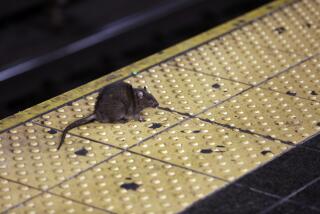Rats Give Lives for Science : Experiment: Five rodents that traveled through space will be studied at UC Irvine in an effort to learn more about effects of weightlessness on muscle tissue.
- Share via
IRVINE — After 14 days in space, five rats from UC Irvine landed aboard the space shuttle Columbia at Edwards Air Force Base on Monday--and were killed painlessly so their muscle tissue can be studied.
Results of the yearlong studies will expand knowledge of how weightlessness causes unfavorable changes in muscle tissue, said UCI scientist Kenneth Baldwin. The studies could also lead to major advances for human health, he said.
Among other things, the research may point to ways to keep bedridden patients and older, less active people from losing muscles needed for full, independent lives.
“We’re doing a lot of basic research that involves preserving the integrity of the muscle system,” Baldwin said in an interview from Edwards Air Force Base in Los Angeles County. “That research has implications for people who are inactive, such as those who have had prolonged bed rest and those in the aging process.”
Baldwin and another UCI scientist, Vincent Caiozzo, are in charge of a project that involves five of the 48 laboratory white rats that flew aboard Columbia. The UCI research, made possible through a $100,000 National Aeronautics and Space Administration grant, focuses on how lack of gravity changes muscle mass.
For NASA, the studies about muscle loss are important for future space travel. Astronauts have so far been able to function in space despite adverse changes in their muscle capability. But NASA officials have said they worry about the impacts of very long trips, such as a manned mission to Mars.
Previous space research has found that muscles in human and animals change in size and ability without gravity.
Caiozzo, an assistant professor of orthopedics, said muscles on humans and animals on the ground can change similarly because of reduced activity. Leg muscles atrophy, for example, when the leg is in a cast. Caiozzo said the NASA muscle research thus could lead to improved ways of helping people recuperate from broken limbs.
*
Baldwin, a professor of physiology and biophysics, said the five UCI rats had to be killed so that their muscle tissue could be studied under microscopes.
Other laboratory rats, not part of the UCI research, had been killed by astronauts while the shuttle was still in orbit. Body parts of those rats also will be studied to learn more about the effects of space travel.
All of the white rats had been purchased at the same time from a laboratory-supply company. Eleven of them were kept on the ground as control subjects and their muscle measurements will be compared to the rats who orbited Earth.
Preliminary research indicates that loss of human or animal muscle in space can be slowed or halted by weight lifting, Baldwin said.
“High-resistance strength training is a common modality to be used,” Baldwin said. “We also know that some types of drugs, such as growth hormones, may be useful” in halting loss of muscle mass.
Baldwin said he and Caiozzo regretted that the five UCI rats had to be killed to complete the research. But he said the legacy of those rats in space may be significant advances in health for both animals and humans.
“We think this is going to be a very successful project,” Baldwin said.






